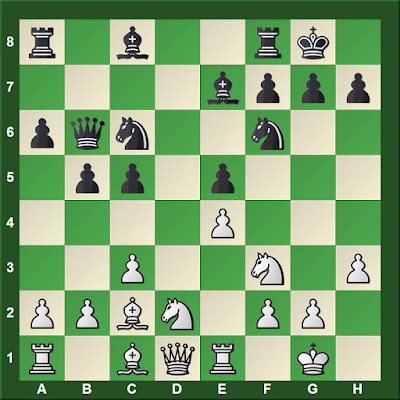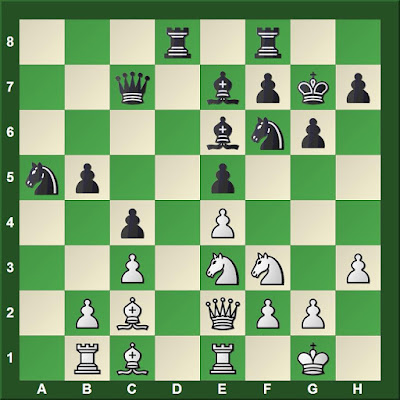Particularly noteworthy was the terrible restraining influence exerted on Black by the continual threat of Nd5. Having completed his development very harmoniously. Black found it difficult to undertake any active plan without allowing the inevitable Nd5. Indeed, he only had to decentralise one piece (20...Na5) and the White knight jumped down his throat.This game, Tal -- Bronstein, USSR Championship 1959, was my lesson of the week for my advanced students. We started with this postion.
Stean, Simple Chess, 18.
White to move
With a definition of outposts written on the white board, I asked students to identify the outposts in this position.
An outpost is a square that might be occupied by one's own piece, ideally supported by one's pawn, and that cannot be attacked by an enemy pawn. With some guidance, the students were able to see that d5 was an outpost for White's pieces, and that d3 was a potential outpost for Black.
We then went through the bulk of the game and Stean's comments.
The diagram above is prior to 14.Nf1. The knight finally occupies the critical outpost of d5 on move 22.
White to move
Stean comments:
The moment we've all been waiting for, not to mention the white queen, rook, and bishop who have been patiently queuing up behind the e-pawn for some time. White's decision to play his trump card now is prompted by the fact that Black's knight has been drawn out of play to a5. This may not seem to be very significant, but with the rapid opening up of the position which must surely follow, the abscence of even a single piece from the central field of battle will cause great difficulties for Black. Stean, Simple Chess, 16.The game as whole is interesting and serves as a good example of employing the threat of an outpost as a strategic and tactical weapon. Restraining the opponent's choices via the threat to occupy an outpost is a notion less evident in Romanovsky's treatment of this topic.
Beginning Students
My beginning students this week solved the problems in Beginning Tactics 9 (see "Lesson of the Week" [13 December 2012]). When they stumbled on the seventh problem, I showed them the game Mayet -- Anderssen 1851 (see "Sacrificial Attack").
















No comments:
Post a Comment